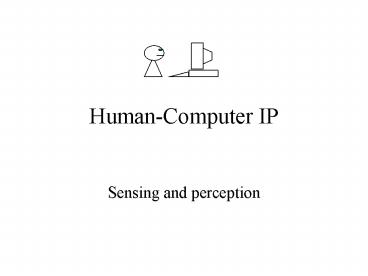HumanComputer IP - PowerPoint PPT Presentation
1 / 78
Title: HumanComputer IP
1
Human-Computer IP
- Sensing and perception
2
Vision Auditory Haptic
Communication modes
3
Storage
Storage
Perception
Perception
Cognitive Proc.
Psycho-Motor o/p
Cognitive Proc.
Psycho-Motor o/p
Sensing
Sensing
Signalling Level
4
Vision Auditory Haptic
Communication modes
5
Data int.
Storage
Knowledge /Reasoning
Signal D/C
Perception
V / A / M o/p
Cognitive Proc.
Psycho-Motor o/p
Signal P/U
Sensing
Signalling Level
6
Vision Auditory Haptic
Communication modes
7
(No Transcript)
8
(No Transcript)
9
Sensing
Language
Cognitive processing
Memory
Writing, sketching
Functionality of the Human
10
Input
Language
Storage
Processing
Output
Functionality of the Human
11
VisionHearingTouch
SMSTMLTM
Language
Cognitive Engine
Psycho-Motor Output
Functionality of the Human
12
(No Transcript)
13
Vision the Eye
- Pupil, iris, cornea
- Retina, fovea, nerve cord
- Cones, at the fovea colour and detail
- Rods, on retina low light intensity
- X-cells at the fovea patterns
- Y-cells elsewhere movement
14
(No Transcript)
15
(No Transcript)
16
(No Transcript)
17
(No Transcript)
18
(No Transcript)
19
Visual Sense
- Visual sense the detection of visual signals
- Visual acuity ability to perceive detail
- Shape size and distance law of constancy
- Brightness reaction to luminance
- Contrast diff. Between object and background
- Dim conditions peripheral vision
- Colour hue, intensity and saturation
- Visual persistence
20
(No Transcript)
21
Visual Perception
- Visual perception the detection of a stimulus
- The Icon
- Visual perception the interpretation of a signal
- The perceptron
- Prior knowledge of objects
- The Schema
22
Properties of visual perception
23
The search for patterns
24
(No Transcript)
25
(No Transcript)
26
(No Transcript)
27
O O
V
28
(No Transcript)
29
(No Transcript)
30
(No Transcript)
31
(No Transcript)
32
(No Transcript)
33
The 3-dimensional perspective
34
(No Transcript)
35
(No Transcript)
36
(No Transcript)
37
(No Transcript)
38
(No Transcript)
39
(No Transcript)
40
(No Transcript)
41
The cultural effect
42
(No Transcript)
43
(No Transcript)
44
(No Transcript)
45
(No Transcript)
46
(No Transcript)
47
(No Transcript)
48
(No Transcript)
49
(No Transcript)
50
(No Transcript)
51
(No Transcript)
52
The effect of Context
53
(No Transcript)
54
(No Transcript)
55
(No Transcript)
56
(No Transcript)
57
(No Transcript)
58
(No Transcript)
59
(No Transcript)
60
(No Transcript)
61
(No Transcript)
62
(No Transcript)
63
- Gestalt principles of perceptual organization
64
the 'selectivity' of perception foregrounding
and backgrounding
65
The principle of proximity
66
(No Transcript)
67
(No Transcript)
68
The principle of similarity
69
The principle of good continuity
70
The principle of Closure
71
The principle of smallness
72
The principle of surroundedness
73
(No Transcript)
74
The principle of symmetry
75
(No Transcript)
76
Reading
- Jerky movement of the eye
- Saccades and fixations
- Fixations account for 94 of reading time
- Regression could become a habit in reading
- Adults read about 250 words/min.
- Words are scanned as a shape
- Negative contrast provides higher luminance,
hence improves acuity.
77
Hearing
- Sound characteristics pitch (frequency)
- Sound characteristics loudness (amplitude or
energy) - Sound characteristics timbre (harmonics)
- Primary input speech carries verbal info
- Able to detect direction and motion
- Attention the ability to be selective
78
Touch
- Touch haptic perception
- Mechanoreceptors to detect pressure
- Thermoreceptors to detect heat
- Receptors for pain (intense pressure of heat.)
- Receptors for acceleration































